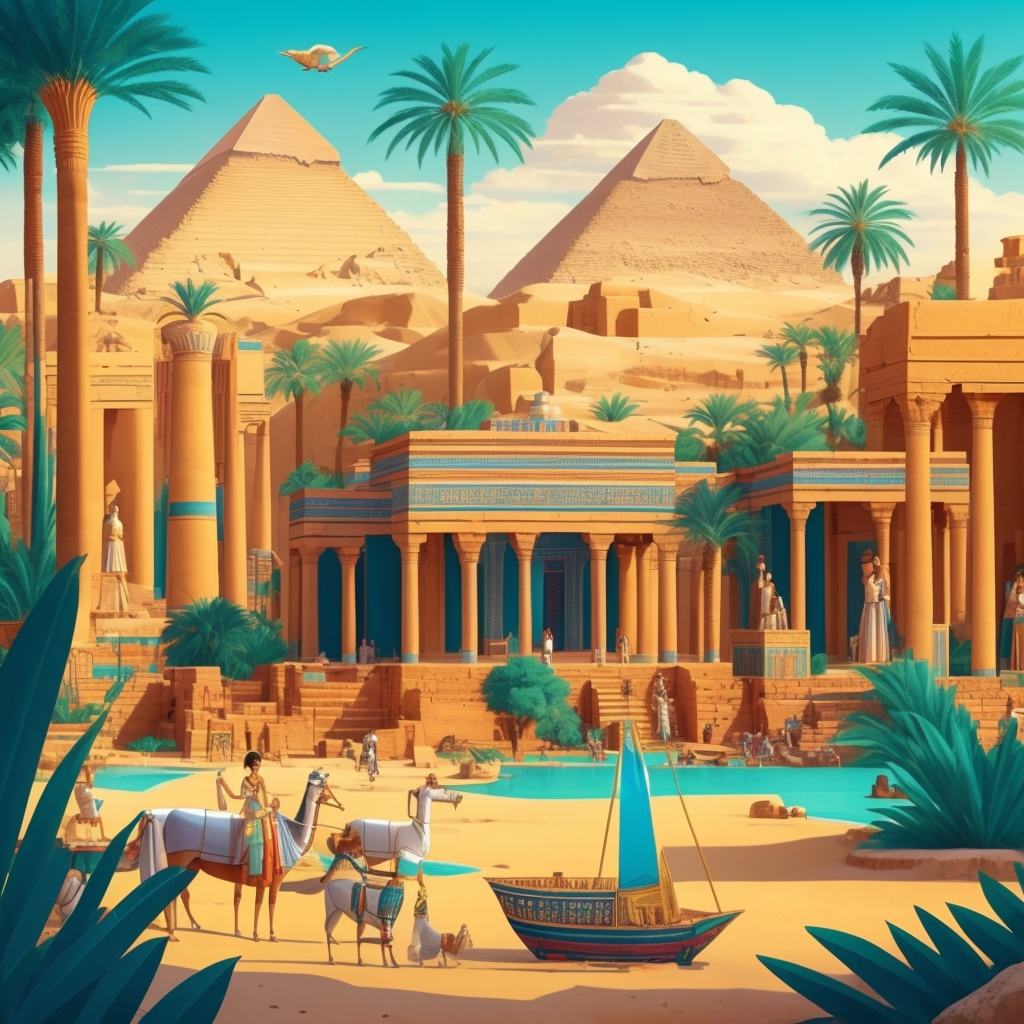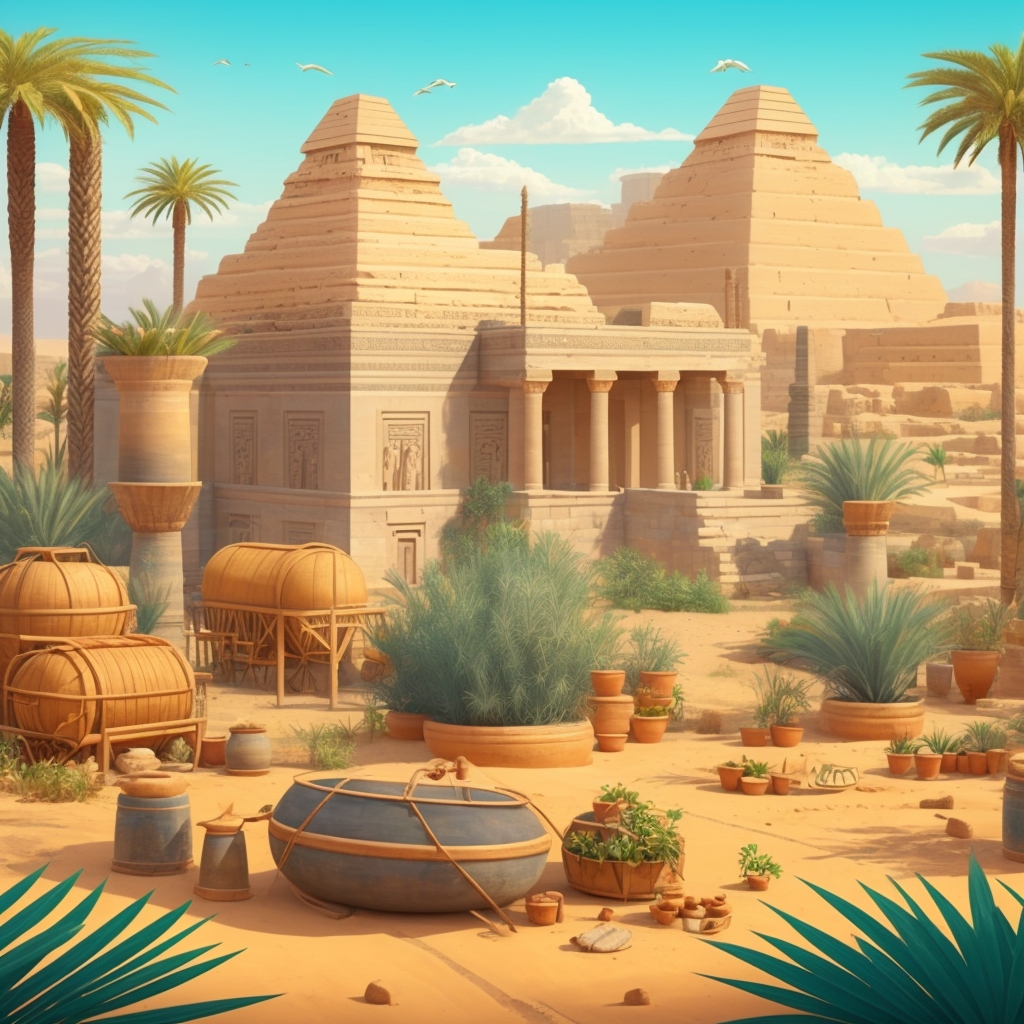Practical Guides to Go Further
These practical guides will help you apply the concepts discussed.

The Pyramid Builder
The ancient Egyptians built the pyramids using simple tools, ramps, and massive human labor. They likely moved huge stones on sledges, possibly using water to reduce friction. Careful planning, skilled workers, and clever engineering made these wonders possible—without modern machines.
The pyramids of Egypt, those truly iconic symbols of an ancient civilization, continue to fascinate the world. What’s interesting is how these massive structures, built thousands of years ago, stand as a profound testament to the sheer ingenuity and unwavering determination of the ancient Egyptians. But how, exactly, were they built? And what purposes did they ultimately serve? This article dives deep into the construction techniques behind these monumental pyramids and their multifaceted role in ancient Egyptian society.
Unpacking Pyramid Construction Techniques
Materials and Methods: A Masterclass in Ancient Logistics
The pyramids were primarily built using readily available limestone, alongside more challenging materials like granite and basalt. Limestone was often sourced locally, which, frankly, made a lot of logistical sense. Granite, however – a much harder stone to work with – was meticulously transported from distant quarries in Aswan. Here’s the thing though: moving these colossal stones wasn’t just about brute force. Modern research, including a groundbreaking 2024 study, has revealed a long-lost, 64-kilometer branch of the Nile, aptly named the Ahramat Branch, which flowed right alongside 31 pyramids. This ancient waterway likely served as a vital “superhighway,” allowing the Egyptians to float massive stone blocks and other materials much closer to the construction sites, dramatically simplifying what would otherwise be an impossible feat of overland transport. For shorter distances, or perhaps in later stages, Egyptians famously used wooden sleds pulled over ramps, often moistening the sand to surprisingly reduce friction.
Construction Ramps: An Enduring Mystery with New Twists
Ramps were undeniably central to the construction process, yet their precise design remains one of archaeology’s most engaging debates. Various theories exist regarding their configuration, including straight, spiral, and zigzag designs. Straight ramps likely served the early construction phases but would have required enormous amounts of material themselves – a logistical headache! Helical or spiral ramps may have been used to reach higher levels, saving space and resources.
But here’s a fascinating, more recent development: a study from mid-2024, focusing on the Step Pyramid of Djoser, proposes an entirely different approach. Researchers suggest that a sophisticated hydraulic lift system might have been employed to raise massive stone blocks, challenging the long-held belief that ramps and rollers were the sole primary methods. This theory, which posits the use of complex water management and possibly even internal wells to float blocks upwards, really underscores the ancient Egyptians’ advanced understanding of engineering and water dynamics. It’s a compelling idea that continues to spark discussion among experts.
Labor Organization: Dispelling the Myth
Pyramid construction demanded thousands of workers, organized with remarkable precision into specialized teams. Contrary to that persistent, frustratingly inaccurate popular belief, these workers were not slaves. They were, in fact, paid laborers who were well-fed, housed, and even received medical care. Construction sites were hierarchically structured, with supervisors and engineers ensuring meticulous coordination and stringent quality control. This complex social and organizational feat is just as impressive as the engineering itself.
The Multifaceted Functions of the Pyramids
Funerary Monuments: A Journey to the Afterlife
The primary, and perhaps most profound, function of the pyramids was to serve as elaborate tombs for pharaohs and high dignitaries. The ancient Egyptians held a deeply ingrained belief in an afterlife, and pyramids were meticulously designed to act as grand vessels for the soul’s ascension to the next world. Burial chambers, often located deep within the pyramid’s core, were richly decorated and meticulously filled with treasures and provisions meant to accompany the pharaoh into eternity. It was, in their view, the ultimate send-off. Interestingly, a March 2025 discovery in Nubia has even begun to challenge the long-held assumption that pyramid burials were exclusively for the elite, suggesting a potentially more inclusive practice than previously thought in some regions.
Symbols of Power and Divinity: God-Kings on Earth
Beyond their funerary role, pyramids also functioned as potent symbols of power and divine connection. As physical representations of the sacred mountain, they embodied the essential link between the earthly realm and the divine. Their sheer scale and astonishing complexity were direct reflections of the pharaoh’s unassailable authority, powerfully reinforcing his status as a living god-king on Earth. You can practically feel the awe they must have inspired!
Cultural and Religious Centers: Beyond the Tomb
Interestingly, some pyramids extended their function beyond just tombs, becoming vibrant religious and cultural centers. They were often part of much larger complexes that included temples, chapels, and ceremonial structures. These spaces actively served as places of worship and pilgrimage, constantly reinforcing the spiritual significance of the pyramids in the daily lives of the Egyptian people.
Concrete Examples and Unfolding Discoveries
The Great Pyramid of Giza: An Enduring Wonder
Built for Pharaoh Khufu, the Great Pyramid of Giza stands as the most famous and, arguably, the most awe-inspiring example of Egyptian pyramid construction. It truly showcases ancient engineering prowess, with limestone blocks weighing up to an astonishing 15 tons each. Its architectural precision, even by modern standards, reflects the truly advanced skills of its builders. What’s more, the “ScanPyramids” project, using cutting-edge muon scanning technology, continues to probe its internal structure, revealing previously unknown voids and hinting that even after millennia, the Great Pyramid still holds hidden secrets. It’s a testament to how much we’re still learning.
The Pyramids of Saqqara: The Dawn of an Era
The pyramids of Saqqara, especially Djoser’s Step Pyramid, mark the very beginning of large-scale pyramid construction in ancient Egypt. This structure is famously considered the world’s first large-scale stone monument, illustrating a remarkable evolution in building techniques. As mentioned earlier, it’s also the focus of that exciting new 2024 theory suggesting the use of a sophisticated hydraulic lift system, potentially rewriting our understanding of early pyramid building. This makes the Saqqara site not just historically significant, but also a hub of ongoing, cutting-edge archaeological debate.
Key Insights and Best Practices from Ancient Egypt
- Strategic Material Sourcing: Efficient logistics were paramount, including sourcing limestone locally and leveraging the Nile’s power for transporting heavier granite from distant quarries. Recent 2024 findings about the Ahramat Branch only underscore this.
- Sophisticated Labor Management: Hierarchical structures and highly specialized teams weren’t just efficient; they were critical for executing such massive, long-term projects successfully. This wasn’t just manual labor; it was organized genius.
- Adaptive Engineering Techniques: The ongoing debate over ramp designs, and the compelling new theories like the 2024 hydraulic lift system, highlight the Egyptians’ flexibility and innovation in overcoming immense construction challenges. They weren’t afraid to experiment!
Frequently Asked Questions
How did the Egyptians move those absolutely massive stone blocks?
Traditionally, it’s believed they used wooden sleds pulled over ramps, often wetting the sand to reduce friction and ease the immense transport. However, recent 2024 research has also highlighted the crucial role of a now-lost Nile branch (the Ahramat Branch) for transporting materials over long distances. And, for the Step Pyramid, a compelling new 2024 theory suggests a hydraulic lift system could have been used.
Were the pyramids built by slaves?
No, absolutely not! This is a common misconception. The builders were, in fact, paid workers who operated under well-organized conditions, with access to food, shelter, and surprisingly, even medical care. Recent discoveries in 2025 continue to reinforce this understanding of their valued status.
Why are pyramids pyramid-shaped?
The pyramid shape is deeply symbolic. It represents the sacred primeval mound from which creation began, and also the soul’s ascent to the heavens, embodying the fundamental connection between the mortal and divine realms. It’s a powerful visual metaphor.
What is the largest pyramid in Egypt?
The Great Pyramid of Giza, built for Pharaoh Khufu, holds that title. It remains one of the Seven Wonders of the Ancient World and continues to be a marvel of ancient engineering.
What kinds of ramps were used during construction?
Theories include various designs: straight, spiral, and zigzag ramps. Each configuration had its own logistical advantages and material requirements, and the debate over which was primarily used continues to this day, with new theories constantly emerging, like the 2024 hydraulic lift proposal for Djoser’s pyramid.
Conclusion: The Enduring Legacy
The Egyptian pyramids are, without a doubt, masterpieces of engineering and profound symbolism that continue to captivate us across millennia. Understanding how they were constructed, coupled with the rich cultural, religious, and political roles they played, allows us to truly appreciate the astonishing ingenuity and resilience of ancient Egypt. These magnificent monuments remain an enduring testament to the legacy of a civilization whose influence, and whose secrets, we are still actively uncovering in 2024 and beyond. To delve deeper into the ongoing archaeological work and rich history, authoritative resources like the Institut Français d’Archéologie Orientale are invaluable.







